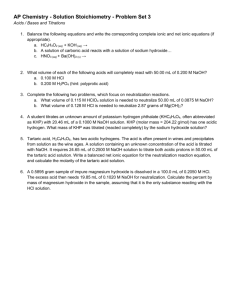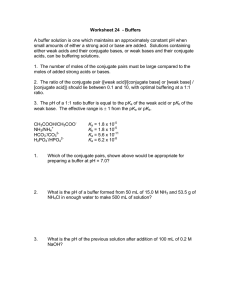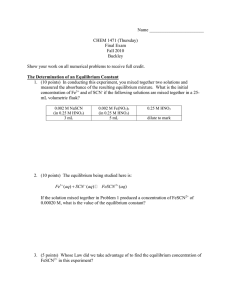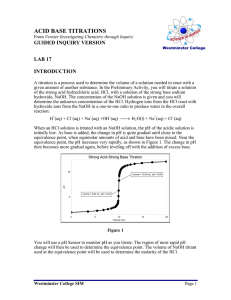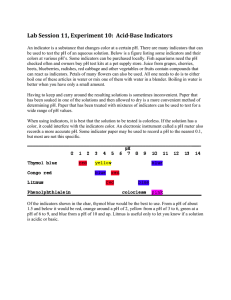Acid/Base and Thermochemistry Test Review
advertisement
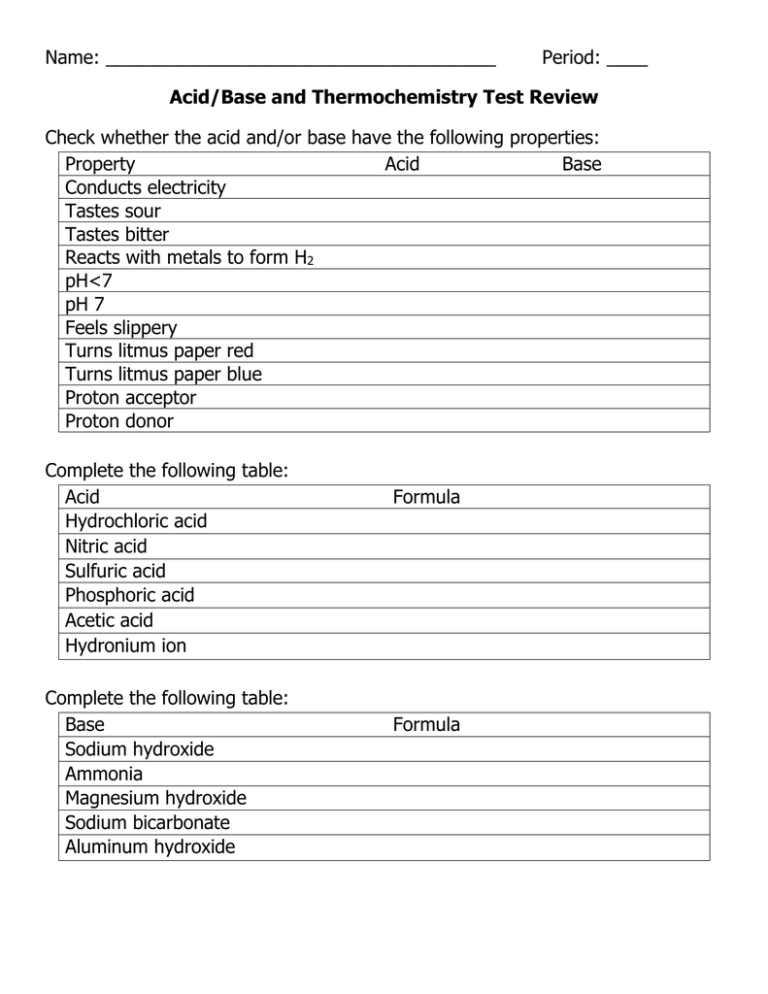
Name: ______________________________________ Period: ____ Acid/Base and Thermochemistry Test Review Check whether the acid and/or base have the following properties: Property Acid Base Conducts electricity Tastes sour Tastes bitter Reacts with metals to form H2 pH<7 pH 7 Feels slippery Turns litmus paper red Turns litmus paper blue Proton acceptor Proton donor Complete the following table: Acid Hydrochloric acid Nitric acid Sulfuric acid Phosphoric acid Acetic acid Hydronium ion Complete the following table: Base Sodium hydroxide Ammonia Magnesium hydroxide Sodium bicarbonate Aluminum hydroxide Formula Formula Conjugate Acid-Base Pairs: For the following reactions, label the acid and base then the conjugate acid and base. NH3 + HOH NH4+ + OHH2SO4 + NH3 NH4+ + HSO4Write an equation that shows the reaction between bicarbonate, HCO3-, and hydrochloric acid, HCl. Label the acid, the base, the conjugate acid, and the conjugate base. pH problems 1. What’s the pH of 0.03M NaOH?______ Is the NaOH acidic or basic? 2. What’s the [H+] and [OH-] of 0.12M HNO3? 3. What’s the pOH of a solution with a pH of 4.7? Is it acidic or basic? 4. What’s the [H+] and [OH-] of the solution in #3? Titrations: 1. Can you explain titration—do you understand it’s based on a neutralization reaction? Do you know the products of a neutralization reaction? Can you explain what end point and equivalence point are? Can you perform titration problems? 2. If it takes 54 mL of 0.1 M NaOH to neutralize 125 mL of an HCl solution, what is the concentration of the HCl? 3. If it takes 25 mL of 0.05 M HCl to neutralize 345 mL of NaOH solution, what is the concentration of the NaOH solution? Summarize the three main acid-base theories in the table below. ACID BASE Arrhenius Brønsted-Lowry For each of the following salts, determine if they are acidic, basic, neutral, or cannot be determined. Na2SO4 MgCl2 CaCrO4 FePO4 Define and give two examples of an endothermic reaction. Define and give two examples of an exothermic reaction. Write whether the enthalpy indicates an exothermic or endothermic reaction. Δ H = –167.4 kJ Δ H = 21.6 kJ Δ H = –143.8 kJ Δ H = –22.1 kJ Δ H = 34.0 kJ List all of the factors that affect the activation energy/reaction rate. Be sure to know WHY each of them are important. What is specific heat? What does it tell about a substance? Aluminum has a specific heat of 0.900 J/(g•°C). How much energy is needed to raise the temperature of a 625 g block of aluminum from 30.7°C to 82.1°C? A 4.00 g sample of metal was heated from 0.00°C to 20.0°C, and was found to have absorbed 35.2 J of heat. Calculate the specific heat and identify the metal. How much energy is necessary to convert a 52.0g sample of ice at -20.0°C to steam at 120.0°C? Follow your heating curve!!! Heating Curves Label the following items on the heating curve: 1. Solid 3. Gas 4. Melting 5. Freezing 6. Evaporating Temperature 2. Liquid 7. Condensing 8. Boiling Point 9. Freezing Point Energy Phase Diagrams Label the following items on the phase diagram: 10. Solid 11. Liquid 12. Gas 13. Melting 14. Freezing 15. Vaporizing 16. Condensing 17. Sublimation 18. Deposition 19. Triple Point 20. Critical Point Answer the following questions based on the phase diagram: 21. What is significant about the triple point? 22. What state is the substance in at room temperature and normal pressure? 23. What phase change would happen if the substance is held at a constant pressure of 10 atm while the temperature changes from 30°C to 150°C?


